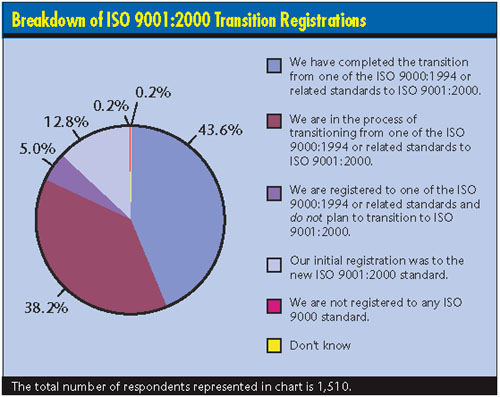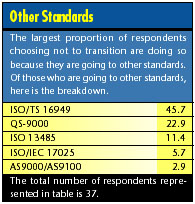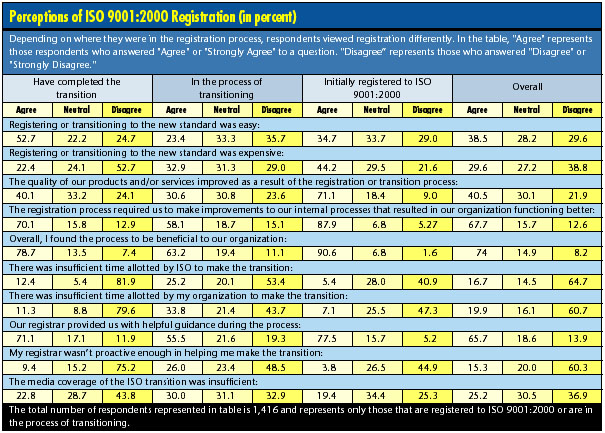| by Dirk Dusharme
This year’s ISO 9001:2000
Transition Survey provides both surprises and encouragement.
Despite predictions from quality publications (ours included)
that organizations and registrars would not have the time
or resources to complete the transition before the Dec.
14 deadline, registrations are much further along than most
believed. Information provided by the registrars to Quality
Digest and others indicates that only about 25 percent
of registered companies have completed the transition. However,
this year’s survey shows that number to be about 53
percent. The survey also shows that both transitioners and
first-time registrants feel the registration process added
value to their organizations.
Because views on the value of the registration process
vary depending on whether you’re registering to the
standard for the first time, are currently transitioning
or have already completed the transition, we divided our
survey results accordingly.
More than 43 percent of all survey respondents report
that they’ve finished the transition to ISO 9001:2000,
38 percent are in the process, 5 percent don’t plan
on transitioning and about 13 percent have never been registered
to an ISO 9000 standard and are registering to ISO 9001:2000
for the first time.
To get a feel for how the transition process is going,
we subtracted respondents who are first-time registrants
and those who don’t plan to transition. After doing
so, the portion of companies that have completed the transition
jumped up to 53 percent--about twice as many as previously
thought--and the percentage of companies in transition climbed
to 46 percent. The reason for the discrepancy from earlier
reports is that Quality Digest and other registration
trackers depend upon data supplied by the registrars. Apparently,
many registrars haven’t had the time to completely
update their registration information, and, as a result,
previous estimates based on such data were inaccurate. However,
because this survey was sent to all Canadian and U.S. registrants,
we believe the results to be the most accurate reading of
the state of registration possible.
As high as these percentages are, 38 percent of about
60,000 organizations--about 22,800 companies--have yet to
transition. The majority of these organizations are handled
by about a dozen registrars that have fewer than six months
remaining to perform audits and complete the process. Although
more possible than first thought, it remains to be seen
how many organizations will make it on time.
The results also reveal that 5 percent--about 3,000 organizations--aren’t
planning on making the transition. Although 5 percent may
seem small, it’s a substantial amount of business
in the highly competitive registration world. More on this
later.

In general, the overall value of the registration process
is most positively perceived among those who have already
completed registration, both first-time registrants and
those that transitioned. Those who are in the process of
transitioning were more reserved in their responses.
More than 50 percent of those who have completed the transition
process agree that the transition was easy, compared to
one-quarter of those still transitioning and one-third registered
to ISO 9000 for the first time.
The cost of transition seems to be an issue mostly for
those registering for the first time. About 44 percent of
first-timers think registration is expensive, compared to
the 22 percent that transitioned and the 33 percent that
are still in the transition process.
There’s a certain sense to this: The cost of registering
for the first time tends to be more expensive than simply
transitioning. Our survey shows that first-time registrants
are much more likely to use consultants. They may also require
more time from both consultants and registrars before they
iron out all nonconformities. Organizations that already
have experience with the standards are less likely to use
consultants and, given prior knowledge of the standards,
will be less likely to have problems with implementation.
All this translates directly into dollars.
One of the most outstanding survey results was the perceived
value of registration. More than 70 percent of first-time
registrants agree or strongly agree that the quality of
their products or services has improved as a result of registration,
with 19 percent strongly agreeing that this is the case.
For those who have transitioned, about 30 to 40 percent
agree or strongly agree that the new standard has improved
products and services, and about one-quarter disagree or
strongly disagree.
Without further investigation, this begs at least a couple
of knee-jerk reactions. The first is that registration to
ISO 9001:2000 provides noticeable value to organizations
that previously have not had a quality management system
in place. Registrars and consultants have, of course, argued
this point for years. But ISO 9001:2000--with its more holistic
approach to an organization’s quality management system
and stronger emphasis on processes--can be seen to provide
much more value than ISO 9000:1994’s purely prescriptive
approach. It could be argued that with ISO 9001:2000, organizations
must have fine-tuned processes, and this can only help to
provide value.
Next, the value of ISO 9001:2000 over the 1994 version
is probably significant. The fact that 30 to 40 percent
of respondents who went through the transition process agree
or strongly agree that it improved products or services
seems to indicate that the new standard is more than simply
rehashing the 1994 version. If the 2000 version were really
no different from the 1994 version, we would expect these
percentages to be smaller. Of course, another interpretation
is that revisiting your QMS for whatever reason, even through
a surveillance audit, provides value.
Respondents who have completed registration also overwhelmingly
agree that the process has led them to make improvements
that resulted in their organizations functioning better.
Almost 90 percent of first-time registrants agree or strongly
agree that their organizations function better as a result
of registration, with 29 percent strongly agreeing with
this. More surprising is that 70 percent of those who completed
the transition from the older standard also indicate that
their organizations function better.
Conclusion: Although respondents report that they get
both external (i.e., better products and services) and internal
value from the standard, the real value of ISO 9001:2000
is perceived to be internal.
Overall, all three groups agree that the registration
process is beneficial to the organization. As with the other
perceived-value questions, the most positive responses came
from first-time registrants. More than 90 percent agree
or strongly agree that the process was beneficial to their
organization, with 38 percent reporting that they strongly
agree.
If you read Quality Digest’s first three
registrar customer satisfaction surveys (July 1999, July
2000 and July 2001), you might remember that the issue of
helpfulness is a tender spot for registrars, which are caught
between rules that prohibit consulting and the need to assist
clients. That said, registrars earned good scores for proactively
leading the way without actually telling clients what to
do. As this survey shows, registrars have learned how to
provide useful information to clients without crossing the
line into consulting.
Nearly three-quarters of those from organizations that
are registered to ISO 9001:2000, both first-timers and those
that transitioned, agree that their registrar had provided
“helpful guidance” during the registration process.
More than 75 percent of respondents who transitioned from
the old standard agree that their registrar was proactive
in helping them make the transition. Only 49 percent of
those in the process of transitioning report that their
registrar is being proactive.

Only between 25 and 30 percent of companies transitioning
from the 1994 standard used a consultant to help with registration,
compared to 66 percent for first-time registrants. This
isn’t too surprising, as it’s likely that organizations
that have already gone through registration feel comfortable
proceeding without a consultant. First-time registrants,
being unfamiliar with the process, are perhaps more likely
to use a consultant.

When asked whether they felt there had been enough time
allotted by either ISO or their organization to make the
transition, 80 percent of the respondents who had finished
the transition indicate that there had been. It’s
no big surprise that this percentage dropped to about 50
percent for those that are still in the process of transitioning.

Five percent of the organizations that are currently registered
to ISO 9000 or a related standard don’t plan to transition
to ISO 9001:2000, according to the survey. The majority
of these companies--about 60 percent--report that they’re
moving to a different standard. The remainder report that
they’re not transitioning because they received no
value from ISO 9000 or because of the cost or complexity
of registration.
Of those that are switching to a different standard, 46
percent report that they’re switching to ISO/TS 16949,
the new automotive standard. For QS-9000-registered companies,
this makes a lot of sense. First, the deadline for becoming
registered to ISO/TS 16949 is as far away as 2006, providing
extra time; second, there will be no need to become registered
to ISO 9001:2000 because the new automotive standard includes
ISO 9001:2000; and third, for organizations that are already
registered to QS-9000, their registration remains valid
until the 2006 deadline.
This year’s survey was faxed to 37,506 fax numbers
pulled from the U.S. and Canadian listings in Quality
Digest’s Online Database of North American Registered
Companies. Of those, 29,325 faxes were successfully sent.
Of those, 1,510 online surveys were completed, a response
rate of 5 percent.
The online survey was designed using SurveyGold from Golden
Hills Software Inc. Responses were collected by Golden Hills
Software and downloaded to Quality Digest at the
survey’s conclusion.
Data analysis was done by Quality Digest. The
choice of data to extract was based on conversations with
registrars and our knowledge of topics that interest our
readers.
Dirk Dusharme is Quality Digest’s technology
editor. Letters to the editor regarding this article can
be e-mailed to letters@qualitydigest.com.
|